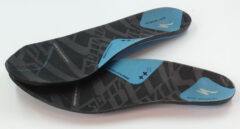Hand comfort is extremely important for long-distance cyclists because many experience problems with cyclist’s palsy, caused by compressed ulnar nerves in the hands. This leads to mild tingling, then numbness, and then lack of strength and control in some or all fingers, which in severe cases (which are not uncommon) can take months to heal.
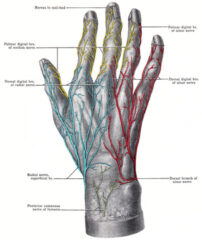
Page Contents:
- Riding Position
- Road & gravel bike front suspension: Specialized Diverge FutureShock & RedShift ShockStop stem
Gloves & Handlebar Tape
The most important part of hand comfort is finding gloves and handlebar tape that you like. My preferred gloves are Specialized Body Geometry (BG) Gel, which have large gel pads on the palms, which I pair with Lizard Skins DSP bar tape, either the 2.5 mm (Amazon) or 3.2 mm (Amazon) version. The Lizard Skins tape is extremely comfortable and amazingly grippy in all weather conditions. I’ve tried using other padded tapes or gel inserts underneath normal bar tape (which can make the bars quite bulky), but for me nothing comes close to the nirvana of Lizard Skins tape.
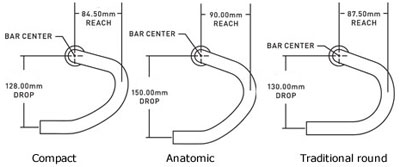
Drop Handlebars
The next most important aspect for hand comfort is the shape of the handlebars, of which there is a wide variety of options even within the category of drop handlebars (see the diagram on the right). Many people find that the modern, compact bar shape works well for them, which has a slightly shorter reach and less drop and a varying radius to the curve. For me, compact drop bars do the best job of distributing the pressure more evenly across my whole hand when in the drops instead of focusing it on one spot. Traditional round bends and ergonomic/anatomic bars with more angled bends are options that other people find comfortable.
In addition to the shape of the drops, handlebars also vary according to the shape of the top section, with some models having a flattened instead of round shape. A moderately flattened shape tends to increase comfort by providing more surface area for the hands to rest on, which is particularly noticeable when holding that part for extended periods on long climbs. Some drop handlebars have an extremely flattened platform on the tops that are marketed as improving aerodynamics may be less comfortable if the hands cannot easily be wrapped around the top section of the bars.
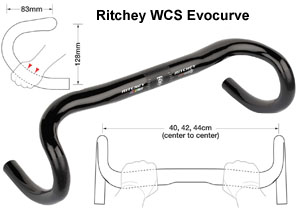
The width of handlebars also varies. The standard method is to match the width of the bars (measured center to center) to the width of the boney protrusions on the front of the rider’s shoulders. However, some people prefer to use a wider bar than this for more control or a narrower bar for better aerodynamics. Be careful when changing handlebar width because certain brands measure bars outside to outside and some center to center, so a 40cm bar from one brand may be the same width as a 42cm bar from another brand or it may be 2 cm narrower. In addition, the lower/drop section of the bar of certain brands, for instance 3T, flares out so that the ends of the bars are 2cm wider than where the brake hoods are mounted.
Carbon handlebars and carbon forks are said to absorb more vibration than aluminum versions, but I find that these subtle differences fall a long way behind differences in glove padding, handlebar tape and Tire Pressure. Carbon bars are typically around 50 grams lighter than aluminum versions. Carbon stems don’t save any weight over aluminum stems and their only advantage is making a stiffer steering response and may help when sprinting, so their value is almost non-existent for ultracyclists.
Using clip-on aerobars is highly recommend for long-distance comfort and aerodynamics (see below). These are designed to mount on a section of round bar with a diameter of 31.8 mm. Almost all modern handlebars are this size at the stem, but many bars change shape or size quickly on either side of the stem and are therefore inappropriate to use with clip-on aerobars. In addition, some carbon handlebars have a section that is the correct size but are not reinforced outside of the stem clamping zone and so are not rated to handle the clamping forces needed to attach a pair of aerobars, so check this with the manufacturer for carbon handlebars.
Finding a handlebar that has a moderately flattened top section, compact bend, and a broad enough central clamping zone to mount aerobars is not so easy. My favorite aluminum handlebars are the Ritchey WCS Evocurve (Wiggle) and the Specialized Expert Shallow Bend. My favorite carbon handlebars are the 3T Ergonova Team (Amazon) (I find the drops too short on the aluminum version, called the Pro, so I don’t recommend that) or the Ritchey WCS Carbon Evocurve (Amazon).
Other Handlebar Styles
There are a small number of people who choose to use straight handlebars to ride long distances on the road. Straight bars tend to put the arms much wider apart than do drop handlebars, which has a large cost in terms of the Air Resistance of the Cyclist and they also offer far fewer hand positions than drop handlebars, even if bar-ends are used, making problems with pinched nerves more likely. The standard position on straight handlebars also places the wrists at a less natural angle than when holding bar ends or the hoods or drops on drop bars, which can cause additional problems with comfort. Trekking/butterfly handlebars can be used to give more positions and so avoid hand problems, but they are still poor aerodynamically. I therefore don’t recommend these bars for ultracycling unless a lot of off-road riding is expected, where they have an advantage in terms of bike handling.
People have occasionally used time trial base bars instead of drop handlebars for bikepacking races. Despite being reasonably aerodynamic, these bars share the problems with straight handlebars in that they offer a more limited number of hand positions than do drop bars, and so are not ideal for most people.
Front Suspension: Stems and Forks
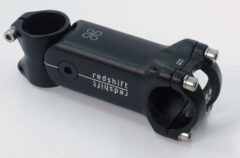
The comfort of road and adventure bikes can be greatly enhanced by adding a bit of front suspension, so there is a post on the Ride Far Blog covering how to get front suspension on a road or gravel bike: Road & gravel bike front suspension: Specialized Diverge FutureShock & RedShift ShockStop stem. The Specialized FutureShock fork found on the Roubaix and Diverge bikes and the RedShift ShockStop stem that can be put on any bike are reviewed in detail, both of which greatly improve front-end comfort. Aftermarket gravel bike suspension forks and the effect of lower tire pressure is also discussed.
How Brake & Shift Lever Style Affects Hand Comfort
Many ultracyclists manage to keep riding while suffering from cyclists’ palsy. The numbness in the hands can cause problems with operating the brake and gear levers. This is one reason why Electronic Shifting and hydraulic Brakes are reasonably popular with ultracyclist, because those levers are much easier to operate when your hands are not functioning properly.
A general overview of the topic of hand comfort is given in this GCN video:
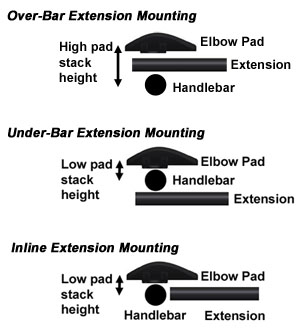
Aerobars / Tribars
The primary reason why aerobars are popular with ultra-distance cyclists is often not the aerodynamic gains (which are significant), but it is the extra comfort that they offer by taking the weight off of the hands and instead using the skeleton to support the weight of the upper body through the elbows. Using aerobars for a significant portion of the time is one of the best ways to avoid hand problems.
Aerobars come in a variety of shapes and have a lot of adjustability, so if you want to use them for a big race or trip, install them as early as possible in your training and play with the adjustments until you are happy. You’ll need to put some time into using them in training to get used to the position and be comfortable controlling the bike while riding on them.
There is a large variety of clip-on aerobars available. As discussed on the Riding Position page, using aerobars with a drop handlebar that is setup at a height that is comfortable for long-distance riding means that one of the most important factors of clip-on aerobars is how close to the base bars they can be mounted. You may find that models that put the elbow pads on top of the extensions that are on top of the base bars forces the elbow pads to be unnecessarily and possibly uncomfortably high (the upper example in the diagram on the right). You may therefore want to only consider models that allow the elbow pads to be mounted with a low stack height above the base handlebars (the lower two examples in the diagram).
Having the elbow pads very close to the base bar may make it difficult to access the hand position of the bar tops, which is a comfortable position to use when climbing. This is more of a problem for people who have a narrower handlebar or prefer to have their elbow pads wider apart, but it is not such a problem for aerobars that have the elbow pads positioned behind the base bar. The elbow pads of most models are fixed, but there are models with elbow pads that are spring-loaded and automatically flip up when not in use and a few, which I prefer, have pads that can be pushed upwards but stay in place if not moved.
Elbow pads also vary in terms of shape, size, and level of padding. Be aware that some smaller pads can prove to be uncomfortable when used for extended periods.
The shape and length of the aerobar extensions is also important, and can be changed on many models. Don’t worry too much about whether the extensions are carbon or aluminum because that won’t affect comfort and the weight difference is marginal. Extensions that are angled upwards at the end (often described as “ski bend”) can provide more comfort due to a more relaxed wrist position than extensions that are flatter (the flatter models are offered because they yield the best results in the wind tunnel, not because they are the nicest to use).
Extensions are normally delivered at maximum length and are designed to be cut down to a more appropriate length. Some extra-short aerobars are available that extend no further forwards than the brake lever hoods; these are made to satisfy the rules in certain triathlon races, which is why they are labeled as “draft legal.” Because those rules don’t apply in ultracycling, I recommend ignoring all such models because they are too short to be comfortable for long distances.
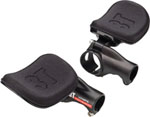
There is only one clip-on aerobar that has all of the characteristics that I recommend, namely a minimal pad height, pads that can be flipped out of the way, and interchangeable extensions, the 3T Flip Clip On (Amazon, shown on left). This model was formerly called just “Clip On”, but that name now refers to a slightly different model and not all retailers have the naming correct. The stock 3T elbow pads are not the largest or most comfortable available, but 3T also sell “Comfort” elbow pads separately in aluminum (Amazon) or carbon (Amazon) that I prefer because they are far larger than the stock version. I prefer the extension shape that 3T calls ‘ski bend’, which are available in aluminum (Amazon) or carbon (Amazon).
Another model of clip-on aerobar that is popular with ultracyclists is the Syntace C3 (Amazon). This model places the elbow pads slightly behind the base bar, which some people prefer due to it being closer to the elbows and so providing better support, and it’s reasonably lightweight. It comes in three lengths, but the extensions cannot be changed.
There is an even more detailed discussion of which aerobars are good for bikepacking on the Cycling About website and see Torsten Frank’s blog post. Also, GCN has some good videos that cover most of the points that I’ve discussed above:
Last significant page update: November, 2016
This page is in the Rider Comfort section. The next page in this section is:

